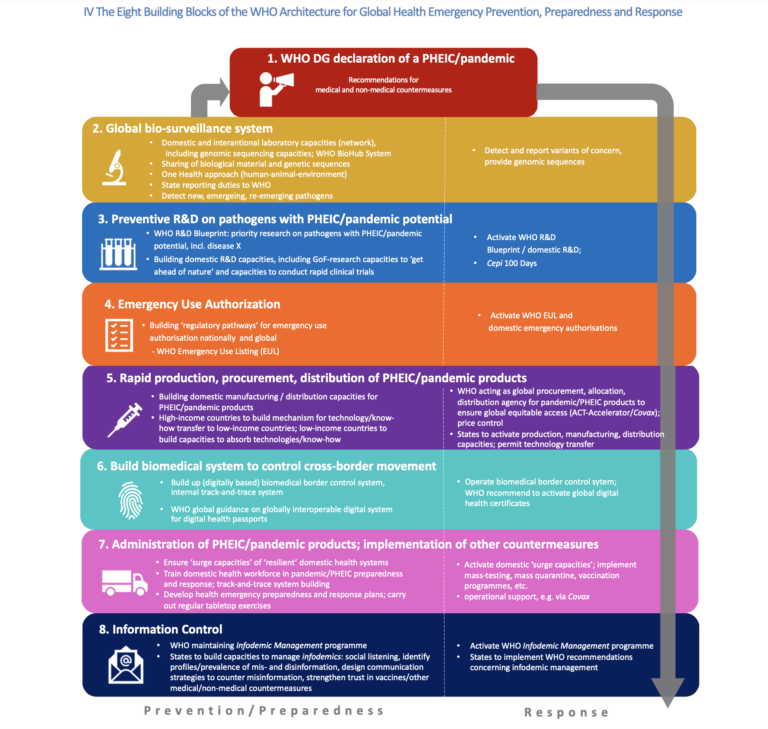“The climate system is a coupled non-linear chaotic system, and therefore the long-term prediction of future climate states is not possible.” -IPCC
This article is a repost with the kind permission of the author
Be forewarned. This is a long essay. Despite what Vice President Al Gore Jr. led many to believe in “An Inconvenient Truth”, there’s no way to be accurate or remotely complete about climate science without using a lot of words. Nevertheless, Gore summarized “the science” in under seven minutes, concluding:
“When carbon dioxide is high, the temperature gets warm.”
Carbon Dioxide is going through the roof, ergo, we are going to fry. Gore told that story to millions of people in 2006. Seventeen years later CO2 levels are higher and nobody has done anything about it. But we are starting to! Governments around the world are uniting under the goal of carbon neutrality. We have a chance to save the planet if we could only act together!
This call for global cooperation also comes with divisive undertones that are becoming less subtle. If you don’t agree you must:
- Not care about the environment
- Not care about your fellow human beings
- Not care about children
- Be uneducated
- Be selfish
- Be a Republican
- Be anti-science
- Be an anti-vaxxer
- Be a conspiracy theorist
This is the story I and nearly all my friends have had in our heads for at least two decades. Earlier this year I realized that there is another group of people that don’t agree with the story. They are never mentioned without being denigrated. They are the dissenting experts.
The science is not settled, and it will take more than seven minutes to explain why that is.
Who is driving the Climate Narrative?
The Intergovernmental Panel on Climate Change (IPCC) was established in 1988 by the World Meteorological Organization and the United Nations Environment Program. The United Nations endorsed its creation later that year. According to Wikipedia:
- The IPCC is an internationally accepted authority on climate change and all member governments endorse its findings
- The IPCC reports play a key role in the annual climate negotiations held by the United Nations Framework Convention on Climate Change
- The IPCC does not conduct its own original research. They assess what is available and report on it.
IPCC opinion drives the scientific consensus on this issue. This is what they concluded in the Executive Summary of their Third Assessment Report in 2001:
“The climate system is a coupled non-linear chaotic system, and therefore the long-term prediction of future climate states is not possible. “
What does this mean?
It is non-linear. In a non-linear system a change in input will not result in a proportional change in output. In other words a small change in atmospheric carbon dioxide could result in a large change in global temperature. This also applies to the myriad of other factors that determine climate, including those that have a mitigating effect on warming.
It is chaotic. This means that the initial conditions present in the system will have unpredictable results over time. As explained by Edward Norton Lorenz, an American mathematician and meteorologist who established the theoretical basis of weather and climate predictability, chaos is:
When the present determines the future, but the approximate present does not approximately determine the future.
Thus, the IPCC working group concluded that “…the long-term prediction of future climate states is not possible.”
But the IPCC authors continue, “Rather the focus must be upon the prediction of the probability distribution of the system’s future possible states by the generation of ensembles of model solutions.”
Taking these two statements together we can fairly say that the IPCC knows that the future climate cannot be predicted yet still believes that it is still worthwhile to continue to make guesses based on where agreement exists across multiple models. This is why two decades later IPCC working groups regularly publish their assessment of available climate models that indicate that global temperatures are dependent upon carbon dioxide levels. It is their opinion that continues to drive the CO2-based global warming narrative around the world and here in the United States.
Indeed, the Biden administration’s “Climate Change Task Force” bases their ambitious goal of establishing a net-zero emissions economy by 2050 on IPCC guesswork. But such an achievement does not come without great cost. What would the benefit be in terms of global warming?
In May of 2023, Senator John Kennedy (R-LA) , ranking member of the Senate Appropriations Subcommittee on Energy and Water Development, questioned the Department of Energy Deputy Secretary, David Turk, about the cost that will be borne by American taxpayers to make the U.S. carbon neutral.
Turk was honest but not necessarily forthcoming. He agreed that an overhaul of this scale would cost trillions and did not contest a 50 trillion dollar price tag.
However when Kennedy pressed him on the benefit of such an endeavor, the Deputy Secretary of Energy did not have an answer. Kennedy stated that he supported carbon neutrality but wanted to know how much it would actually slow the warming of the planet. He asked the direct question:
“If we spent $50 trillion to become carbon neutral by 2050 in the United States of America, how much is that going to reduce world temperatures?”
Turk did not have an answer. He didn’t know because nobody does. The long term prediction of future climate states is still not possible.
What’s wrong with the IPCC’s approach?
Despite admitting that the long term prediction of future climate states is impossible, the IPCC continues to regularly churn out Assessment Reports.
The IPCC’s most recent working report is given here. It is an extensive and highly technical document. The matter of relevance is their estimate of climate sensitivity which is defined as the rise in global temperature from a doubling of atmospheric carbon dioxide.
According to the IPCC, climate sensitivity is 3 degrees Centigrade. This is their best estimate based on the instrument record and paleoclimate data. The summary of their analysis of these data are given in section 7.5 of their working report.
I have five critiques of the IPCC approach:
- There are only a handful scientific papers considered by the IPCC panel. How and why did they choose these studies and not others?
- Throughout their summary and the papers that they cite, acknowledgement of uncertainty and estimation abounds. It is commendable that the authors of these papers state the limitations in their work yet there is an undeniable disconnect with the promulgated idea that global warming from rising CO2 emissions is an established fact and cannot be contested. Shouldn’t the IPCC be concerned that their findings are being miscommunicated to the public?
- The instrument record uses only very recent data, beginning anywhere from the late 19th century to the 1950’s. Although there is a positive correlation between CO2 and temperature over this span of time, there are multiple decades where CO2 and global temperatures are inversely correlated. Moreover, a 170 year period is a relative blink of an eye with respect to the multiple processes involved in establishing a new equilibrium temperature. When temperatures and CO2 are examined over hundreds of thousands of years there are much longer periods where there is no positive correlation between carbon dioxide and temperature.
- Paleoclimate data, the record of temperatures on Earth going back hundreds of thousands of years, is vitally important. Although there was no carbon dioxide contribution to our atmosphere from human activity, how and why temperatures fluctuate over longer time scales independent of human activity may tell a different story about what our future climate will be. Yet the IPCC cite studies such as this one, which downplay the accuracy and relevance of such data:
Natural climate variations during the Pleistocene are still not fully understood. Neither do we know how much the Earth’s annual mean surface temperature changed in detail, nor which processes were responsible for how much of these temperature variations. Although our understanding based on climate models is steadily increasing most studies are focused on individual time periods such as the Last Glacial Maximum (LGM) to facilitate inter-comparison between different models and with data compilations, and do not consider temporal changes over longer timescales (e.g. Braconnot et al., 2007a, Braconnot et al., 2007b).
But a significant source of Paleoclimate data exists in the Antarctic ice cores which show a remarkably consistent relationship between atmospheric CO2 levels and temperature. This relationship is robust yet has been offered in a distorted manner to the public (see below).
- The biggest shortcoming throughout IPCC reports is the underlying assumption that atmospheric CO2 levels will always drive global temperature, yet it is clear from the ice core data that the opposite is true. We are presently in between ice ages, an interglacial period. Prior to every ice age, CO2 levels were high, yet global temperatures plummeted anyway. Thousands of years later CO2 followed.
Large and growing criticism of the IPCC’s assessments, practices and integrity
Despite the characterization of all critics as uneducated, selfish and misinformed there are tens of thousands of experts who have come forward to dispute the IPCC position while risking their own credibility and careers in doing so. What are they saying?
Global Warming Policy Foundation
In 2011 another climate organization, the Global Warming Policy Foundation, published this extensive critique of the IPCC. It is written by Ross McKitrik, PhD, a professor of Economics at the University of Guelph and author of two books that oppose the so-called “climate consensus”.
McKitrik offers numerous examples that demonstrate
- Conflicts of Interest among Lead Authors in the IPCC
- An opaque process of Selecting IPCC Lead Authors
- Selection of poorly qualified Lead Authors
- A lack of any commitment to examine the full range of scientific views
- Loopholes and gaps in the peer review process
- Deficiencies in estimates of Climate Sensitivity
- A pattern of dismissal of many criticisms leveled against the IPCC
- Delegates from member nations are often not qualified or interested in the subject
Furthermore, McKitrik summarizes the significance of IPCC emails from the University of East Anglia’s Climate Research Unit which were leaked in 2009, some of which demonstrate an intention to deliberately distort the messaging around scientific conclusions. “Climategate” continues to be dismissed by various mainstream sources as an attempt to exaggerate IPCC’s duplicity by “climate change deniers”. However McKitrik cites several rational and independent perspectives on the implications of these communiques.
Jon Howard, former Prime Minister of Australia and self-proclaimed climate agnostic, wrote the foreword to McKitrik’s forty-three page summary, urging readers to consider the “well-researched and articulate critique of the IPCC’s methods” which “deserves careful study, especially by those who remain in an agnostic state on this issue”.
The Global Warming Petition Project
Tens of thousands of scientists and mathematicians support the Global Warming Petition Project, which seeks to bring light to the fact that many qualified voices stand united against the idea that human released CO2, methane and other greenhouse gases will result in catastrophic heating of the Earth’s atmosphere.
They offer this extensive analysis of evidence that contradicts IPCC findings.
CLINTEL
Climate Intelligence Foundation (Clintel) is an independent organization that operates in the fields of climate change and climate policy. Clintel was founded in 2019 by Delft University of Technology emeritus professor of geophysics Guus Berkhout and science journalist Marcel Crok. Clintel’s main objective is to generate knowledge and understanding of the causes and effects of climate change as well as the effects of climate policy.
Clintel summarizes their views in a one-page World Climate Declaration, a living document that is frequently changed based on input from all its ambassadors and other experts which states:
- Natural as well as anthropogenic factors cause warming
- Warming is far slower than predicted
- Climate policy relies on inadequate models
- CO2 is plant food, the basis of all life on Earth
- Global warming has not increased natural disasters
- Climate policy must respect scientific and economic realities
The CO2 Coalition
CO2 Coalition is a non-profit scientific organization that seeks “to strengthen the understanding of the role of science and the scientific process in addressing complex public policy issues like climate change. Science produces empirical, measurable, objective facts and provides a means for testing hypotheses that can be replicated and potentially disproven. Approaches to policy that do not adhere to the scientific process risk grave damage to the economy and to science.”
This organization has dozens of scientists, engineers and mathematicians as members who offer an evidence-based counternarrative to the IPCC’s position on CO2. Their website contains a plethora of publications and summaries written by members as well as data from reputable sources like NOAA which can be viewed and easily interpreted by the curious layperson like this:
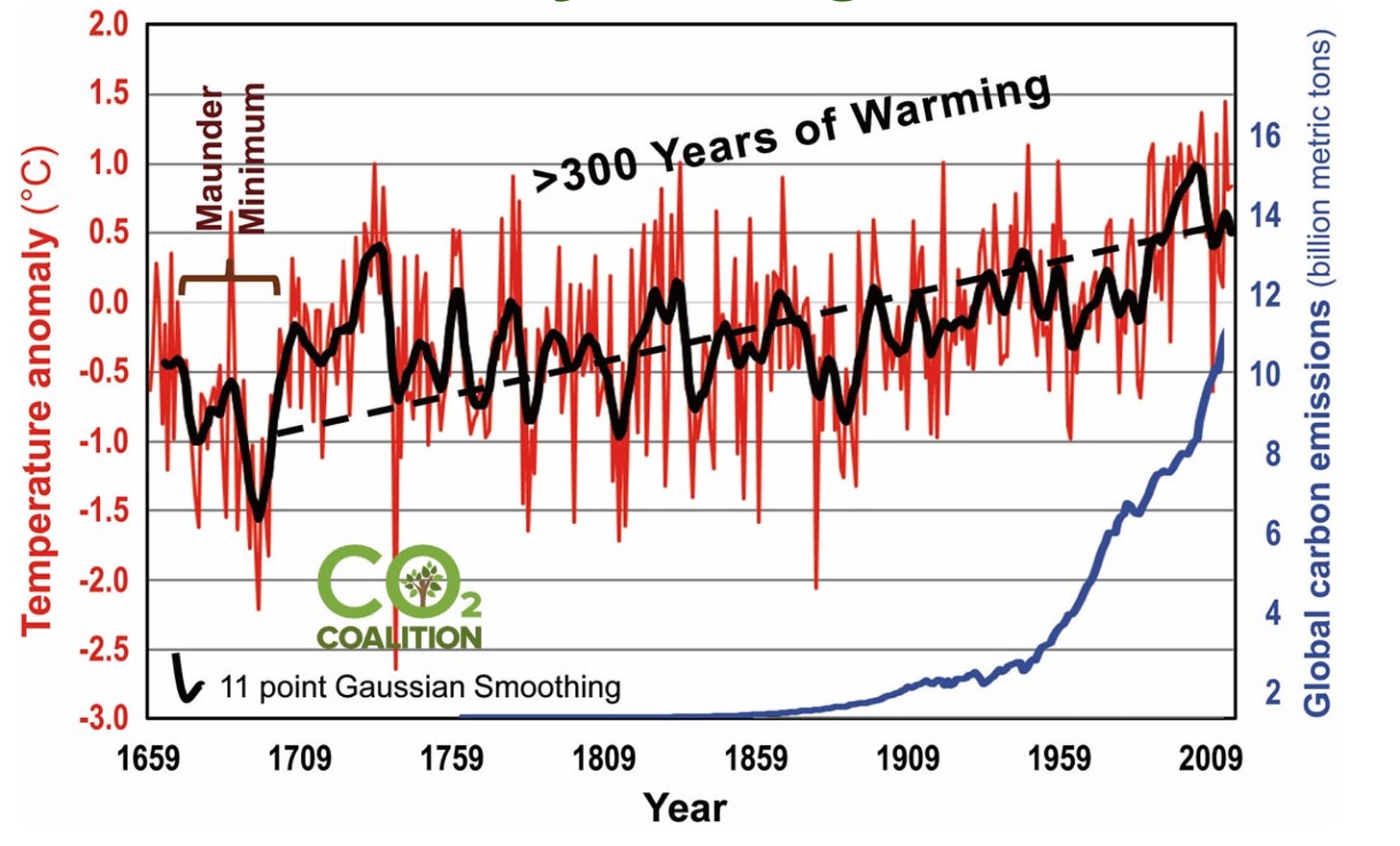
The data above shows that there has been a 350 year period of warming that began two centuries prior to carbon dioxide emissions from human activity. The temperatures were taken from the Central England temperature record, which is the oldest continuous thermometer-based temperature record going back to 1659. Why didn’t the IPCC cite this instrument data?
Why is the public unaware of the controversy around CO2 driven global warming?
How can the layperson know who to believe?
There is undoubtedly a coordinated effort to suppress dissenting opinion around this topic. To demonstrate this for yourself, try to use your browser to locate the citations given above using general search queries. They will be buried among hundreds of results which all attempt to paint any skeptical opinion as unfounded pseudoscience.
Perhaps the most important influence upon public opinion was the movie “An Inconvenient Truth” which aired in 2006. In it, former Vice President Al Gore delivered a convincing argument that CO2 produced through human activity would lead to an inevitable climate catastrophe unless drastic actions were taken. His efforts won him a Nobel Prize in 2007 which he, incidentally, shared with the IPCC.
To the casual moviegoer Gore made an airtight case for the IPCC’s position on CO2 driven global warming. Before taking a closer look at how Gore and director Davis Guggenheim were able to instigate a worldwide call to action, let us first enumerate what can be agreed upon.
- Establishing a net-zero economy will be exorbitantly expensive.
- CO2 levels are at approximately 420 parts per million (ppm). This is significantly higher than levels in the last several hundred thousand years.
- Over long periods of time, CO2 and temperature move in tandem. This is demonstrated in ice core samples from Antarctica.
Here’s how Vice President Gore explains climate science in just under seven minutes:
He begins by showing the audience the correlation between temperature and atmospheric CO2 over the last 1000 years in this screen shot (temperature in red, CO2 in blue):
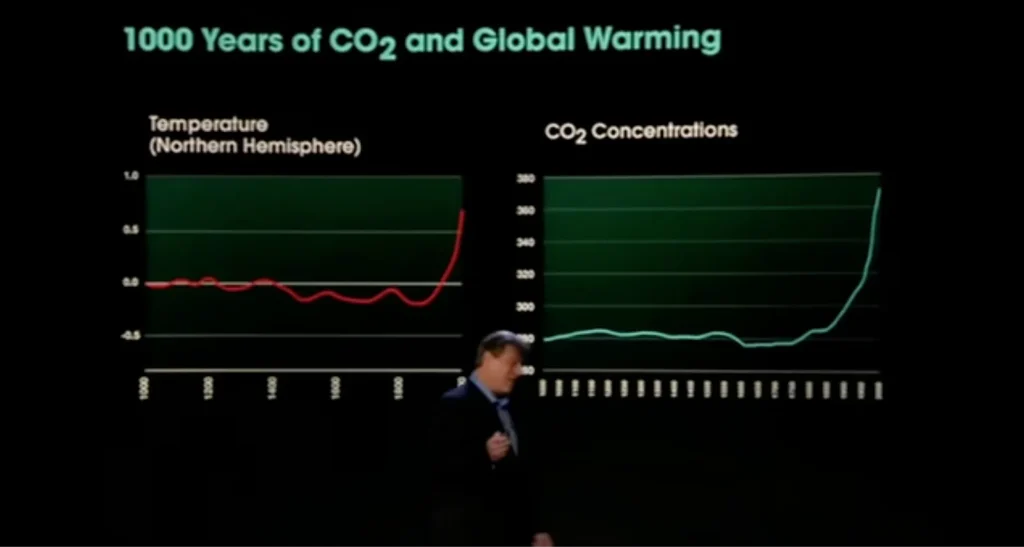
The two plots do “fit together” but notably there are decades-long fluctuations in temperature that are not correlated with CO2. Then around 1850 and the introduction of coal burning engines, both CO2 and temperature rise dramatically.
Is CO2 driving the temperature up? Or is temperature driving CO2 up? Most people know that CO2 is a greenhouse gas. More of it in our atmosphere will cause greater absorption and retention of heat from the sun. Fewer people realize that the solubility of CO2 drops as water gets warmer. Our oceans are an immense reservoir of CO2 and participate in the exchange of CO2 with the atmosphere in a much greater way than human interaction with the environment. There is a third possibility: both are moving independent of each other, at least in this extraordinarily brief period in geological terms.
Which is happening first? How much are they dependent on each other?
No matter what you believe, neither question can be answered from the two graphs alone.
Next, Gore gave the audience more data to drive his assumption home. He shows a plot of CO2 levels going back 650,000 years:

Interestingly, Gore and Guggenheim decided to switch colors on the audience. Red is now used for CO2. Was this an oversight, or was it deliberate? More importantly, before showing us how temperature changed, Gore counts off the last seven ice ages by showing us the periodic dips in the CO2 before temperatures are shown. Then, temperature (now in blue) is shown with CO2:

There are several things to notice in his presentation of the data:
- Gore never explicitly says that drops in CO2 cause drops in temperature, but by showing us CO2 first and suggesting that it can accurately “predict” ice ages, some viewers will undoubtedly assume that CO2 must be the driving factor of global temperatures. Though never stating it, he implies it at 03:41: “When there is more carbon dioxide, the temperature gets warmer.” This is true. It is also true that when temperature gets warmer, there is more carbon dioxide.
- If the graphs that show carbon dioxide and temperature going through the roof in the last 150 years were alarming, Gore makes it even more compelling by demonstrating that what we are seeing now is indicative of a pattern that has been in play for the better part of a million years. However by showing data over a much longer period, the timescale makes it even harder to see which is happening first, a change in carbon dioxide or a change in temperature.
- The obvious questions which Gore never answers are why was CO2 so high hundreds of thousands of years ago and why did it fall? Why did CO2 rise 40% from 200 ppm to 280 ppm 25,000 years before the industrial revolution, and why does this happen about every 100,000 years?
This is what happens when Gore’s temperature and CO2 data are superimposed:
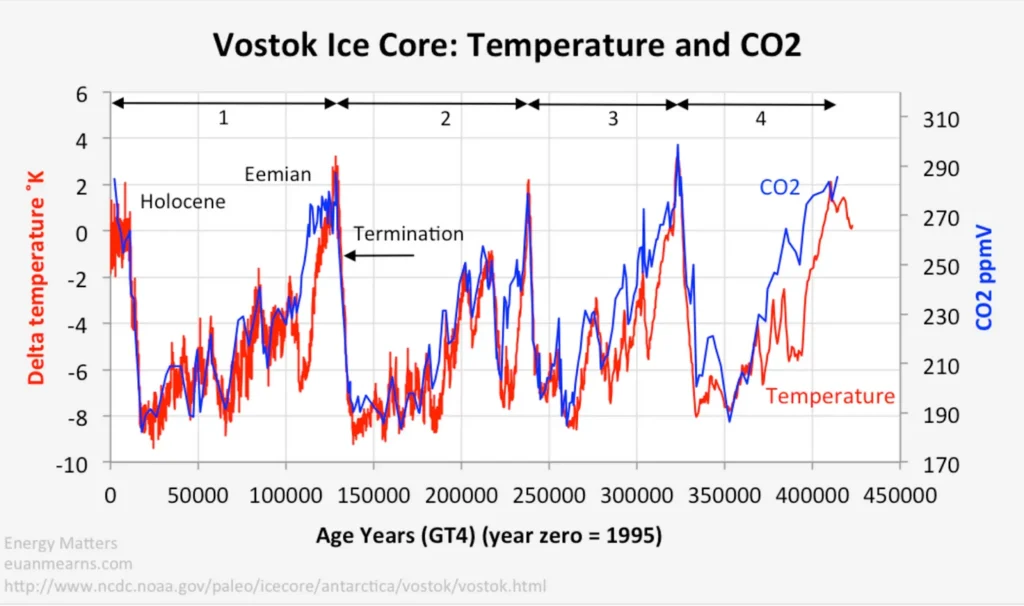
This data was taken from the National Oceanographic and Atmospheric Association and published here. Present day is to the left. Just as Gore showed us, the Earth plunges into a period of significant cooling regularly, and it happens when CO2 is at its highest. When we examine a timeframe that includes only the last ice age it is clear that CO2 dropped eight thousand years after temperature fell. Less obvious but discernible is the rise in temperature which precedes an increase in CO2 at the end of an ice age. Temperature moves first:

Examining Gore’s own data properly completely upends what Gore was implying. Yes, CO2 is a greenhouse gas that can contribute to global warming, but global temperatures move largely independent of CO2 concentrations. This fact would have certainly been too—what’s the proper word? inconvenient? to mention. Is this why the audience was never shown the superimposed plots?
What has caused temperature to fluctuate if it isn’t atmospheric CO2? The driving force behind large changes in temperature is not carbon dioxide. It is the amount of solar radiation (insolation) the Earth is exposed to. Insolation is a function of three cyclic variables: eccentricity of the earth’s orbit, obliquity, or the angle of Earth’s axis with respect to Earth’s orbital plane and orbital precession which changes the direction of the Earth’s axis of rotation with respect to the plane of the Earth’s orbit around the sun.

Taken together, these three cyclical variables, the Milankovitch Cycles, also known as orbital control, explain why the Earth experiences ice ages every 100 thousand years or so. This is indeed the period of the large global temperature cycles apparent in the graphs that Gore showed us above. He did not mention this phenomenon but instead simply said that the ice ages were occurring when atmospheric CO2 levels were lowest.
When examined at this time scale it is also clear that interglacial temperature changes much more rapidly and independently of CO2 levels. We are presently at such a time. Notice the relatively frequent changes in temperature during the Holocene period at the left of the graph. Temperatures have fluctuated over a 4 degree centigrade range over the last 12,000 years despite the preindustrial CO2 levels during this period.
This variation in temperature during the Holocene period is also reflected in ice core data from the opposite side of the world, in Greenland:

Data from both polar regions demonstrate a fluctuation in temperature over a four degree centigrade range independent of anthropogenic contributions.
Gore admitted that the relationship between carbon dioxide and temperature is complicated but said,
There is one relationship that is far more powerful than all the others, and it is this: When there is more carbon dioxide, the temperature gets warmer – because it traps more heat from the sun inside.
Carbon dioxide does trap more heat inside, but that does not explain the data that he presented. Nevertheless, by twisting the significance and meaning of the evidence, Al Gore closed the case on carbon dioxide in the court of public opinion. If the data irrefutably proves that we are headed to a climate disaster, why did he choose to completely misrepresent it?
Carbon Dioxide levels are higher than they have been for 500,000 years
This is true and uncontested. NOAA estimates that carbon dioxide levels are at 420 ppm, 50% higher than pre industrial levels (280 ppm). The impact of such an increase, i.e. climate sensitivity, is, as explained earlier, debatable. Vostok Antarctic ice core samples do not track any period of time where there has been this level of CO2 in the atmosphere.
A 50% rise in CO2 has resulted in an atmospheric composition that is 99.98% the same as it was three hundred years ago. This can be shown graphically. Here is the composition of our atmosphere today:
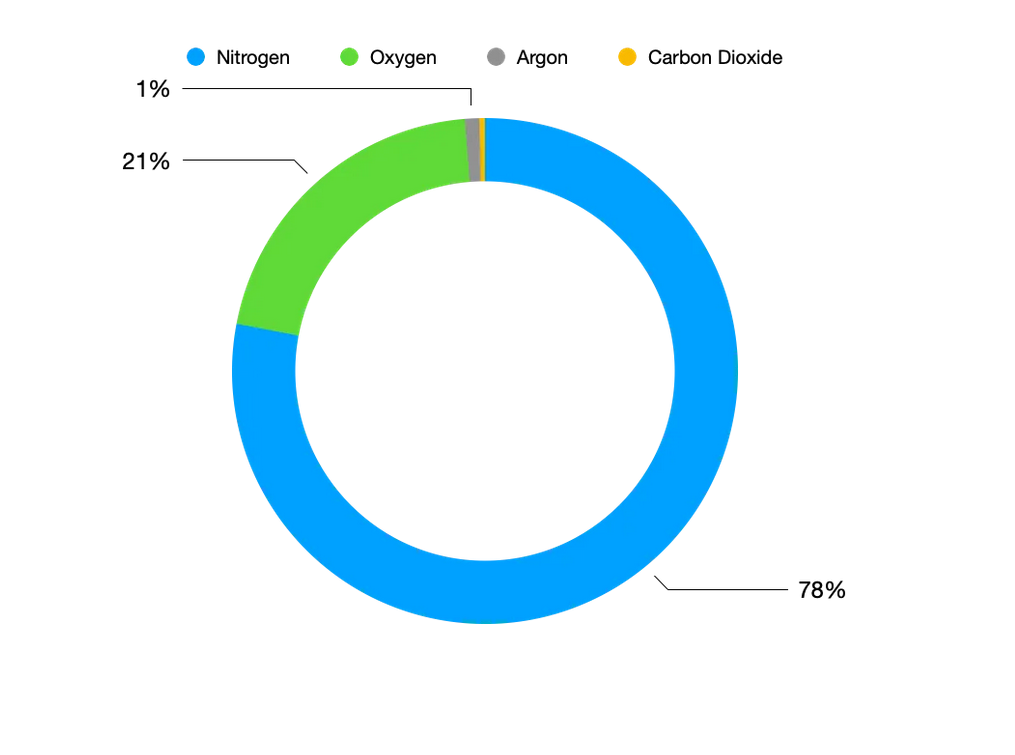
Returning to pre industrial CO2 levels would result in an atmosphere that looks like this:

Could this minute change arrest a relatively modest warming of the planet? Or are the carbon dioxide alarmists exaggerating the benefit of a 50 trillion dollar investment in our future?
The reality is that this is likely not an either/or question. Though carbon dioxide and other greenhouse gases like methane make up only a tiny portion of our atmosphere, they and water vapor are responsible for keeping our planet at a relatively balmy average temperature. Nitrogen and Oxygen, which together comprise 99% of our atmosphere, do not absorb electromagnetic radiation from the sun or what is reflected back from the surface of the Earth.
The greenhouse gas effect is far more complicated than the public realizes and is beyond the scope of my expertise and this article. It is possible that a 50% rise in carbon dioxide will result in a 1-2 degree rise in average global temperature over the next 50 to 100 years. It is possible that this change in temperature will occur independent of CO2 levels as paleoclimate data has evidenced. It is also possible that temperatures will reverse their gradual trend over the next decades independent of what we do.
The scientific literature, when openly and critically considered, tells us that we can at best only make educated guesses. Yet the public is being fed a highly simplified version of reality which uses concepts like “climate catastrophe”, “inevitability”, “consensus” and “rogue expert dissenters”. Many may feel that this tactic is necessary to take action, but this too is only a guess.
Final Thoughts
None of the information given here is an argument for the unmitigated use of fossil fuels.
Instead we can agree that
- Every attempt to use efficient and clean energy sources should be made in order to limit toxic pollutants (carbon monoxide, benzene, particulate matter) to enter our atmosphere.
- Carbon dioxide should not be considered a pollutant; it exists in our bodies at 120 times the concentration than in the atmosphere.
- It is vitally important to protect our waterways and forests – the blood and lungs of our planet – from non-biodegradable waste, like plastics.
- We have available to us highly efficient, zero-emission, solar powered carbon mitigation systems. They are called trees. They and other photosynthetic organisms will flourish with rising CO2 levels to provide a natural buffer.
Despite the inherent uncertainty in predicting transient global temperatures even in the near future, the Earth is inescapably headed towards another ice age. Paleoclimate data and the Milankovitch cycles confirm this. We understand the mechanism behind it. Yet panic about irreversible global warming is being stoked through media and governmental agencies while calls for calm and circumspection are labeled as pseudoscience and even dangerous misinformation.
Furthermore, movies like “An Inconvenient Truth”, which was no more than a public messaging campaign, deliberately omit important points and present data disingenuously.
Who is to be trusted at a time like this? Al Gore and Davis Guggenheim? The IPCC? The climate change deniers? Our government has an answer: them. But at such a time when innovative ideas ought to be explored and supported, we must remember that our own authorities have a history of suppressing ideas that could result in enormous benefit at times like these.
The last time the we got a peek at the kinds of ideas which are being hidden from the public was in 2010 through a FOIA request. To my knowledge this is the only Patent Security Category Review List that has ever been declassified. This is a vitally important document. It gives us an inkling about the kinds of technologies the government is interested in keeping hidden, as a matter of public safety and national security of course.
We can understand the need to prevent new ideas about explosives and missile guidance systems from getting out to the public but what is the intent in keeping things like these secret:
- high energy per volume batteries (Group XI, item 1)
- unusual and efficient energy conversion devices (Group XI, item 3a)
- solar photovoltaic generators with greater than 20% efficiency (Group XI, item 8)
- energy conversion systems with efficiencies greater than 70% (Group XI, item 9)
- vehicular drag reduction systems (Group XIX, item 12)
- any invention directed to fuel economy and efficiency (Group XXIII, item 8)
While pushing the public to accept the sole solution of carbon neutrality, our government has been quietly interested in keeping ideas around fuel efficiency and economy away from public knowledge for at least fifty years or more.
We are thus faced with many more inconvenient truths:
- The public’s understanding of “the science” is woefully inadequate yet they are being goaded into trusting it.
- Loyalty to the IPCC position is being consolidated while evidence of its biases, lack of rigor and integrity continues to be ignored or forgotten entirely.
- There is a significant and growing number of experts that are calling for a referendum on the net-zero initiative but they are being shadow-banned and attacked.
- Intergovernmental panels and agencies like the UN and the W.H.O. are gaining more authority over national sovereignty with every real, exaggerated or imagined calamity. There is little or no organized resistance to this emergent phenomenon.
- Our own government has a long history of lack of transparency around technology and “the science”. Personally, I believe it entirely possible that our authorities could have largely liberated us from carbon emissions with technologies that they have sequestered away behind locked doors. With their track record it would be naive to think they didn’t.
- Attaining a net-zero economy with regard to carbon dioxide is ambitious and extremely expensive. The cost of such an undertaking will be borne by our children, our grandchildren and their grandchildren as well. Like every effort to prevent a huge tragedy, whether that be a war, pandemic or a rise in global temperature, the price will be disproportionately paid by those who can least afford it.
Despite a costly effort to reduce carbon dioxide emissions, it is plausible CO2 will continue to rise in the near future, as will temperature, for unrelated reasons. Attempting to change the unchangeable at enormous cost to humanity could very well be the ultimate exercise in futility.
Even if such a global effort over the next generation temporarily slows the warming of the planet, what kind of planet do we wish to live upon? One where disagreement will be considered dangerous? One where our activities will be monitored, measured, restricted and taxed—measures that will surely be sanctioned to keep us on target?
I ask earnestly, is it really worth it?




